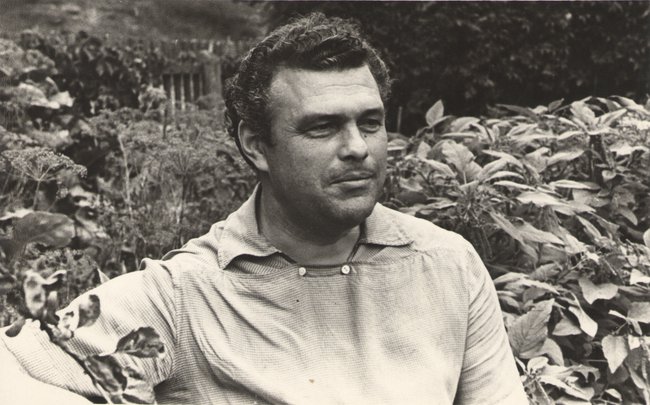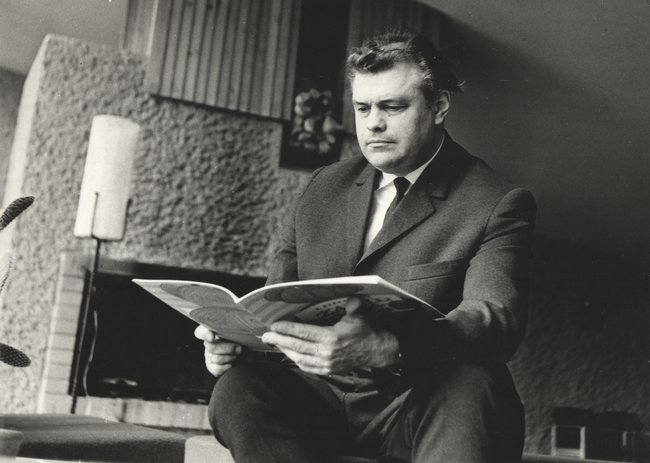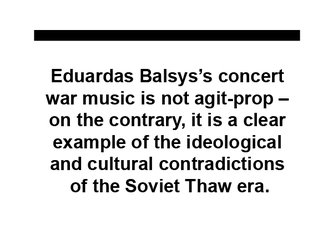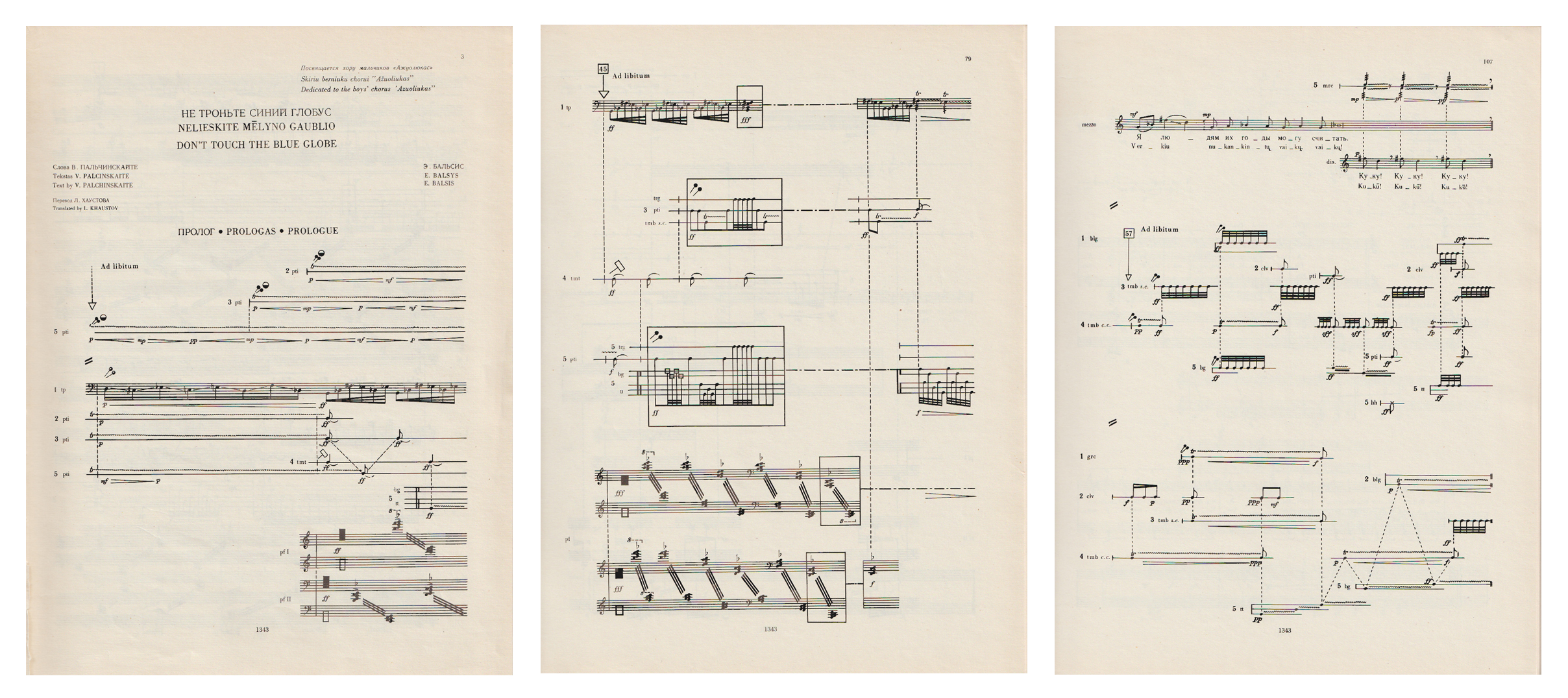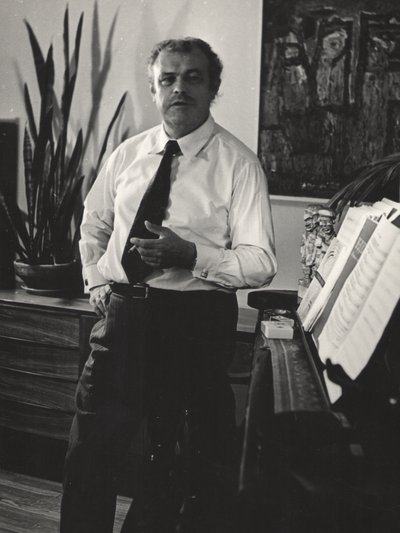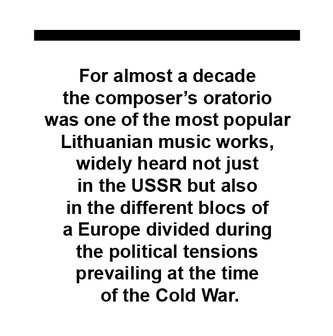Rūta STANEVIČIŪTĖ | Eduardas Balsys’s "Don’t Touch the Blue Globe": Soviet Metamorphoses of War and Peace
The wars of the 20th century made their mark on musical culture in differing forms. The clearest echoes are to be found in war-themed music, in which not only World War I and in particular World War II are pictured in musical sounds but also the geographically diverse history of local conflicts and armed clashes (or peaceful revolutions).[1] Next to this remarkable layer of the past century’s musical culture there is also the even more prolific war music without a particular theme which came into being or was perceived as the expression of the presentiment of horrific events, traumatic memory, escapism and other kinds of personal and cultural experiences of war. Glenn Gould, for example, thought that Sergei Prokofiev’s Seventh Sonata ‘with its schizophrenic oscillation of mood and its nervous instability of tonality, […] is certainly a war piece’.[2] The list of music imagining war would be incomplete if we did not mention the rebirth of military music in the political confrontations and the war-steeped 20th century. This in turn led to the revival and recreation of musical imagery developed in the musical practices of the past and connected with war. In Soviet Lithuania, the first notable examples of art music with a war theme were written in the 1960s. In the post-war period, the cultural space was dominated by the official discourse of war, strongly affected by the cultural confrontations and political tension of the Cold War. During that period Soviet ideology imposed the theme of peace on composers, which, together with the ideologically codified subject matter of the glorification of the new Soviet reality and the friendship of nations, dominated in Lithuanian art music into the 1960s. The theme of war resurfaced during the Thaw – it was at the end of the 1950s and in the 1960s that it received new interpretations in the work then being created in Lithuania. Compared to other fields of the arts, Lithuanian war music was a later phenomenon. Some of the most striking musical works on this theme during the period under discussion were Eduardas Balsys’s (1919–1984) unnamed diptych: Dramatinės freskos (Dramatic Frescoes) for violin, piano and orchestra (1965) and the oratorio under discussion here, that is, Nelieskite mėlyno gaublio (Don’t Touch the Blue Globe) for three soloists, children’s choir, two pianos, double bass and a percussion group (1969).[3] It is worth mentioning that during the Thaw the composer wrote a good amount of film music on the theme of war, in which he had the opportunity to develop the arsenal of musical tools to portray war.[4] In the context of the political thaw and ideological liberalization war had begun to be portrayed in a non-heroic way, through the eyes of an ordinary participant. It was this interpretative approach that provided the foundation for the subject of Eduardas Balsys’s oratorio – it can be surmised that his experience as a film composer also played a part. It was performers who were the driving force behind the oratorio and commissioned the poet Violeta Palčinskaitė, who had witnessed the Holocaust, to write the text.[5] Even though a specific event is portrayed in the composition – the bombing of pioneer camp in Palanga at the very beginning of the war in Lithuania, the subject, it would seem, is not based on a real historical event. Balsys’s oratorio is an example of traumatic memory about historical events. This shift from the portrayal of reality (war) to the memory of its events reflects the more general tendency of 20th century war music, a tendency which is subject to the logic of making trauma a symbol. In terms of musical style Balsys’s oratorio is a striking example of the turn to modernism in Lithuanian post-war music. In the context of 1960s and 1970s musical innovation this composition is held to be a case of compromise aesthetics: components of dodecaphonic, aleatory and sonoristic techniques were incorporated into the moderately modern, ideologically sufficiently neutral neo-folkloric type of style. It should be noted that in the 1960s Balsys wrote several works close in style in which he attempted to reconcile Schoenberg and Shostakovich, the composers representing the most striking ideological and musical antagonism of the Cold War, that is to say, the Western and Soviet versions of modernism in music. Such an ideologized stylistic opposition is most clearly revealed in the above-mentioned Dramatic Frescoes. However, the stylistic spectrum of Balsys’s oratorio, as also of other works by the composer in the 1960s, is not limited to the associations of this ideologized opposition in the period under discussion. Here in particular we have to mention the layer of symphonic jazz very important to the composition’s style and meaning, continuing the strategy favoured by the composer of paraphrasing and incorporating elements of secondary folk (popular urban music) into the fabric of art music. Even though the stylistic mix characteristic of Balsys’s music even in the 1970s was described by Lithuanian music critics as normative Soviet modernism,[6] the reception of post-war moderate modernism in contemporary musicology is changing and encouraging more in-depth studies of this phenomenon. Arnold Whittall, for example, thinks that the canon of modern music from 1945 to 1975 was markedly affected by the more moderate mainstream of composers, in particular those who were successful in combining innovation and familiarity, individualism and accessibility.[7] The music of many composers belonging to this tendency is marked by a host of stylistic and cultural allusions, encouraging discussions about their interpretative contexts. Referring to the cultural connotations of the Cold War, Richard Taruskin called this tendency ‘an amalgam of generic and specific signifying devices: always allusive, but always elusive as well – code without key. […] But they can be read in many other contexts as well’.[8] Similarly, the musical material in Balsys’s oratorio is not ‘neutral’ but rather subject to the strategies of the formation of expressive content. The principle of inversion plays an important part in both the literary subject matter and musical development of the oratorio. It is the idyllic portrayal of the world of childhood which makes up the core of the poetic level of the composition. The tragic resolution of the events of war is revealed gradually, with the insertion of the comments of a dead child, a choir of dead children, a Mother and the mask of a Dead City into the dialogues of children and their teacher, as if from the distance of time. In spite of the particularly broad stylistic palette, one could call the musical fabric a very specific inversion of a musical pastorale. The part of the child at play in the first part of the oratorio is developed from the traditional intonations of Christmas bells, a stylization of the world of children’s games and toys. Besides that, Ona Narbutienė also discerned connections of intonation and harmony with the melodies of Lithuanian polyphonic songs (sutartinės).[9] In the course of the work the same motif is transformed into a solemn march, accompanied by the sound of funeral bells. In describing Balsys as someone who further developed classical conflict dramaturgy, the Lithuanian musicologist Algirdas Ambrazas highlighted the strategies characteristic of the composer’s work of reconfiguring associative musical material – integration and antithesis, which brought his method of composing closer to the modern technique of collage.[10] Another feature typical of Balsys’s musical modernism is the resemantization of musical material.[11] In this regard, the resemantization in the oratorio reveals the effect of ideological norms and constraints on the composer’s musical imagination. For example, in the case of normative Soviet modernism the use of dodecaphony to create a threatening atmosphere, tragedy and traumatic memory was held to be typical. The musicologist Ona Narbutienė, the author of the first monograph on Balsys, wrote in the decade in which the oratorio was composed that at the time the attitude was widely held that ‘the dodecaphonic system is suitable to express […] the dark side of life’.[12] Going deeper into the Lithuanian musical period (from the late 1950s to the end of the 1960s) of the early mastery of the techniques of dodecaphony and serialism, one can see how the ideological reception of these compositional tools gradually became less negative. Ekaterina Vlasova thinks that the breakthrough in Soviet music was determined by the plenum of the Union of Soviet Composers in 1966 with its focus on dodecaphony, after which the identification of this compositional technique as an unwelcome ideology began to disappear from the official musical discourse.[13] The semantic reworking of the meaning of dodecaphony in Balsys’s work changed somewhat later, during the late period of the composer’s dodecaphonic work (1965–1984). Nevertheless, the negative semantics of dodecaphony in his oratorio Don’t Touch the Blue Globe is capable of more than one interpretation and does not just blindly reflect its ideologized understanding at the time: this impression is created by the associations with the interval structures of the series with the intonational properties of folk music thematism.[14]
An additional weight of meaning is provided in Balsys’s oratorio by the composer’s timbral imagination, employed for producing various semantic inversions. The culturally codified grouping of soloists, choir groups, instruments and their ensembles ‘destroys’ the technological order of serialism and the asemantization of this musical idiom (equated to creative freedom in Western countries) in exactly the same way as the earlier mentioned connections and oppositions of the series and a folkloric intonational system. However, whatever the case may be, the application of dodecaphony and other idioms of modern music in Balsys’s oratorio and more widely in his later work, as well as their interaction with reworked foreign material and diverse stylistic references, show the multi-dimensional processes of the semantization of features of the second period of modernism in the context of the ideological tensions of the Cold War.
The reception given to Balsys’s composition was particularly symptomatic. For almost a decade the composer’s oratorio was one of the most popular Lithuanian musical works, widely heard not just in the USSR but also in the different blocs of a Europe divided during the political tensions prevailing at the time of the Cold War.[15] It should be noted that it was especially popular in the German Democratic Republic where an attempt was made in the same decade to reconcile communist ideology and the doctrine of serialism.[16] Different from the situation in the USSR, the conviction was widely held in the 1960s official discourse in the GDR that serialism was particularly useful for the purpose of revealing the new socialist context and the ideological confrontations of the Cold War.[17] On the other hand, the reception of the oratorio in the West up to the end of the Cold War, it is thought, is witness to the influence of left-wing ideology on interpretations of the work.[18] In such an environment the oratorio fitted into the stream of propaganda works for peace, representing more the motif of the threat of atomic and other wars characteristic of the Cold War rather than a narrative connected with the memory of World War II. Due to these ideological connotations Balsys’s oratorio, in spite of its musical qualities, saw a significant fall-off in performances after the collapse of the USSR.Eduardas Balsys’s concert war music is not agit-prop – on the contrary, it is a clear example of the ideological and cultural contradictions of the Soviet Thaw era. In the opinion of Alexei Yurchak, the culture of that period, like the everyday life of Soviet people, does not fit into the opposition conformism-nonconformism, rather it reflects the complicated symbiosis of Soviet and non-Soviet artefacts and images, norms and deviations. As an example, Yurchak presents everyday facts and private life – the juxtapositioning of the portraits of Leonid Brezhnev and John Lennon on the shelf of a teenager’s book case, as well as collecting western rock music albums and at the same time the writings of Vladimir Lenin.[19] Likewise, the artistic discourse on war during the Thaw and the early period of Stagnation was a tool not only to describe the relationship with the past. As with the theme of war in Lithuanian feature films in the 1960s, Balsys in his war diptych attempted to portray the present with the help of musical means of expression and capture the emotional codes and corporeal rhythms of self-perception at the time. It is, as it were, a portrait of a contemporary, and at the same time the testimony of an artist’s contradictory attempts to accept the ‘new’ reality foisted on him and find one’s individual creative face in the field of normative culture.
Translated from the Lithuanian by Romas Kinka
The article is based on a previous text by the author: Rūta Stanevičiūtė. War imagination in music by Vytautas Bacevičius and Eduardas Balsys. Lithuanian Musicology Vol. 14, 2013, pp. 25–38.
[1] As examples of the latter one can mention compositions as different to one another as Karel Husa’s Music for Prague 1968 (1968), Frederic Rzewski’s Attica (1972) and George Crumb’s Black Angels / Vietnam Quartet (1970).
[2] Tim Page, editor. The Glenn Gould Reader. New York: Knopf, 1984, p. 166.
[3] Lithuanian works on the theme of war worthy of mention from the period under discussion are Vytautas Jurgutis’s vocal cycle Kareivio laiškai (Letters of a Soldier, 1964) and Julius Juzeliūnas’s Pasakalija-poema (Passacaglia-Poem) for symphony orchestra (1962).
[4] Tiltas (Bridge, 1956), Gyvieji didvyriai (Living Heroes, 1960), Žingsniai naktį (Steps in the Night, 1962).
[5] Ona Narbutienė. Eduardas Balsys. Vilnius: Baltos lankos, 1999, p. 111.
[6] Juozas Antanavičius. Apie lietuvių muzikos stilių įvairovę (About the variety of Lithuanian musical styles). In Muzika 6. Edited by Jūratė Burokaitė. Vilnius: Vaga, 1986, p. 8.
[7] Arnold Whittall. Individualism and accessibility: the moderate mainstream, 1945–75. In The Cambridge History of Twentieth-Century Music. Edited by Nicholas Cook, Anthony Pople. Cambridge: Cambridge University Press, 2004, pp. 368–369.
[8] Whittall, op. cit., p. 383.
[9] Narbutienė, op. cit., p. 200.
[10] Algirdas Ambrazas. Eduardo Balsio muzikos tautinis savitumas (National identity in the music of Eduardas Balsys). In: Narbutienė, op. cit., pp. 202–203.
[11] Peter Bürger has written about resemantization as a characteristic tendency in the second period of modernism, see: Peter Bürger. The Decline of the Modern Age. Telos 62, 1984, pp. 117–130.
[12] Ona Narbutienė. Lietuvių kompozitorių meninio mąstymo naujovės (Innovations in the artistic thought of Lithuanian composers). Pergalė, 1966, No. 7, p. 131.
[13] Ekaterina Vlasova. The Struggle of Artistic and Propagandistic Trends in the Soviet Music of the 1960s: The Plenum of the Union of Soviet Composers of the USSR in 1966, devoted to Dodecaphony. Sociocultural Crossings and Borders: Musical Microhistories. Edited by Rūta Stanevičiūtė and Rima Povilionienė. Vilnius: Lithuanian Academy of Music and Theatre, ISCM, 2015, p. 229.
[14] Cf. Ambrazas, op. cit., p. 201.
[15] The initial reception of the oratorio is covered briefly in Ona Narbutienė’s 1999 monograph, see: Narbutienė, op. cit., pp. 118–119.
[16] Cf. Laura Silverberg. Between Dissonance and Dissidence: Socialist Modernism in the German Democratic Republic. Journal of Musicology 26, No. 1, 2009, pp. 44–84.
[17] One of the most popular dodecaphonic compositions in the 1960s was Hans Eisler’s Lenin Requiem, composed back in 1937. The tendency under discussion to portray the threat of atomic war was clearly represented by Paul Dessau’s cantata Appell der Arbeiterklasse (1962) and Orchestermusik No. 3 Lenin in which the ideology of socialist realism is reconciled with the techniques of serialism and aleatoricism.
[18] Such a pro-Soviet reception of music from the USSR was particularly marked in France, in which the interpretative contexts of new music in the post-war years were heavily influenced by the intellectual elite’s ideological confrontation with the official discourse and cultural initiatives of the USA in post-war Europe. This has been widely written about, for example, by Mark Carroll in his Music and Ideology in Cold War Europe. Cambridge: Cambridge University Press, 2003.
[19] Алексей Юрчак. Это было навсегда, пока не кончилось. Последние советское поколение. Москва: Новое литературное обозрение, 2014, pp. 384, 391–392.
